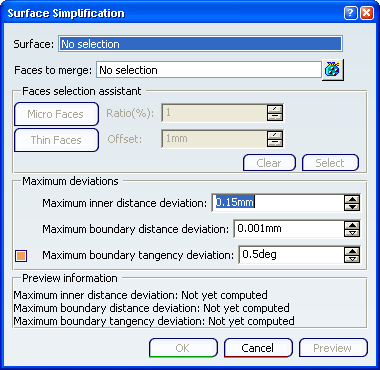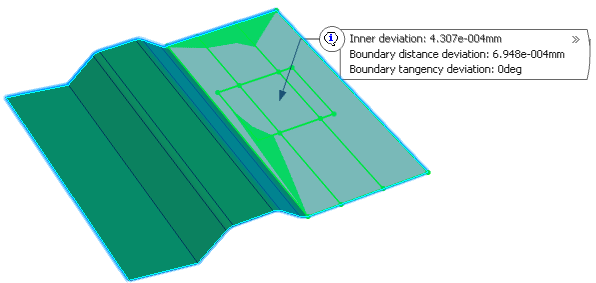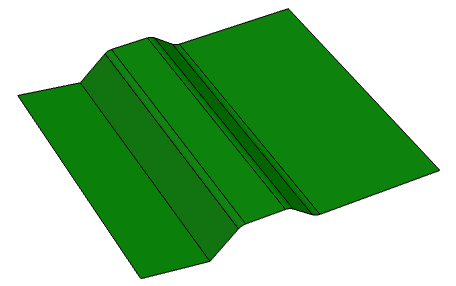Click Surface Simplification  in the Operations toolbar (Join-Healing sub-toolbar). in the Operations toolbar (Join-Healing sub-toolbar).
The Surface Simplification dialog box appears.

In the Surface box, select the surface to be simplified.

In the Faces to merge box, select the faces from the input surface to be merged.
You can select several faces by clicking  . .

Optional:
In the Faces selection assistant area:
You can select the micro faces as the faces to be merged by defining certain ratio. - In the Ratio box, type the value or use the arrows to enter the ratio of the area of any individual face you want to merge with respect to the area of the complete selected surface.
By default, the ratio is set to 1.
- Click Micro faces to select the faces to be merged.
Micro faces have the area less than or equal to the ratio defined.
- Click Select to retrieve these micro faces.
The retrieved micro faces are selected as faces to be merged and the Faces to merge box is automatically updated.
- To cancel the selection, click Clear.
or You can select the thin faces as the faces to be merged by defining the offset value. - In the Offset box, define the value by which the boundary of an individual face can offset inwards.
By default, the offset value is set to 1mm. If a face is created by offsetting the boundaries of an existing face inwards, with offset value more than or equal to the value defined in the offset box. If this new face does not have any matter, it is defined as a thin face.
- Click Thin faces to select all such faces to be merged.
- Click Select to retrieve these thin faces.
The retrieved thin faces are selected as faces to be merged and the Faces to merge box is automatically updated.
- To cancel the selection, click Clear.
Click Preview.
In the
Preview information area, you can visualize the deviation information.

In the
Maximum deviations area, you can type the value or use the arrows to change values in the following boxes:
- Maximum inner distance deviation: allows you to define the maximum possible inner distance deviation the resulting surface can have as compared to the input surface.
By default, it is set to 0.15mm.
- Maximum boundary distance deviation: allows you to define the maximum possible boundary deviation the resulting surface can have as compared to the input surface.
By default, it is set to 0.001mm.
- Maximum boundary tangency deviation: allows you to define the maximum boundary tangency deviation the resulting surface can have as compared to the input surface.
By default, the check box is selected and the value is set to 0.5deg.
Click OK. The surface (identified as Surface Simplification.xxx) is added in the specification tree.

|